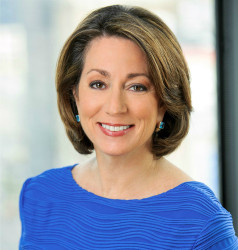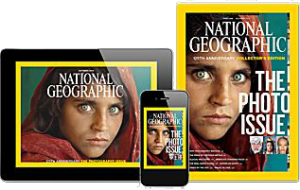The first woman to lead National Geographic magazine discusses her career path, how women are faring in the media industry today, and the opportunities and challenges that lie ahead
Susan Goldberg’s promotion to Editor in Chief of National Geographic last month, after having joined the organization only four months earlier as Executive Editor for News and Features, demonstrates the magazine’s confidence in her, along with its desire to drive big change. National Geographic recently promoted several women, moving four into executive leadership roles—for first time coming close to balancing the gender scales at a large publishing company. Susan is the 10th editor of the magazine, and the first woman to step into the EIC role in the company’s history.

“The differing standards of acceptable behavior are infuriating…. Speak up—but not too loudly. Take charge—but don’t be bossy. Gosh, it’s a complicated needle to thread.”
—Susan Goldberg, EIC, National Geographic
As she finds herself at a key point in her career, and at the center of pivotal change at National Geographic, I wanted to share Susan’s story and perspective on the publishing industry. I had the opportunity to speak with her this week to learn more about her background, the path that led her to National Geographic, and the opportunities and challenges in an industry experiencing disruptive change.
Susan’s story begins in Ann Arbor, Mich., where she grew up. She got the journalism bug in the 8th grade, when she did a paper on “Opportunities in Journalism,” though she spelled opportunities wrong. She’s not sure why or how she picked the topic—no one in her family was involved with journalism—but her interest may have been sparked by her intense interest in watching television coverage of the Vietnam War, as she saw how information affected decision and action, and how it could empower people to push for change.
In the summer after her junior year at Michigan State University, Susan got an eight-week reporting internship at the Seattle Post-Intelligencer. She loved it—and when the when the Editor said, “Hey, kid, why don’t you stay?” she did.
But that meant she had to call her father, a college professor, to tell him that she was dropping out of college. “There was silence on the phone. A long silence,” she said. “Then my father said something I never would have expected: ‘Good for you. We’re proud of you.’ To this day, I find myself amazed, encouraged, and empowered by that support.” (Susan did eventually complete her degree in journalism, by attending night classes.)
During her time in Seattle, Susan wrote a freelance piece for the Detroit Free Press, her hometown paper, about Detroit’s mayor, who had said some outrageous things during a visit to Seattle. This was before the emergence of the Internet and the 24/7 news cycle, and he had never expected his words to be captured, much less communicated back to Detroit.
That story, and Susan’s drive in pitching it to the Free Press, opened a door for her. The paper offered her a job as a reporter; two years later, in 1984, she became the first female reporter to be sent to the state Capitol to cover the governor and legislature. She eventually returned to Detroit as an Assistant Editor on the city desk.
From there, Susan moved on to the San Jose Mercury News as an editor. She was working as City Editor at the time of the Loma Prieta earthquake in 1989, and the newspaper was awarded a Pulitzer Prize for its coverage of the event and its aftermath. She subsequently moved to Washington, D.C., where she spent 10 years at USA Today, moving up the ranks to eventually serve as the newspaper’s Deputy Managing Editor.
At a Crossroads
In 1999, following the death of her husband, Susan was at a crossroads in her life, and she decided to accept an offer to return to the San Jose Mercury News as Managing Editor. “People always say that when you have a major life event, you shouldn’t make any big decisions,” Susan said. “Well, I ignored that advice, and I think that decision saved my life—it forced me to start over.”
During her time in San Jose, Susan was promoted to Editor of the newspaper—becoming the first woman to hold that role. But when the newspaper went up for sale and changed ownership, she wondered what her next move should be.
While she was mulling the future, Susan received an invitation to discuss becoming the top editor at the Cleveland Plain Dealer, one of the largest metropolitan papers in the country and the biggest newspaper in Ohio. Initially, she decided not to have the discussion; she was reluctant to disrupt the life she’d settled into with her new husband and family. After some reflection, though, she realized that it was a major opportunity and was really meant to be her next step. So she took the job—and was again the first woman to lead that newspaper—and began a commuter marriage. “Working at the Plain Dealer was my favorite job, until a few weeks ago,” she noted. “Cleveland had a great mix of staff, community, and issues to report on. And I was at a place in my career where I was really ready for it.”
In 2010, Bloomberg approached her, and what was supposed to be a West Coast-based job that would reunite her with her family quickly transitioned into the bigger role of leading Bloomberg’s Washington bureau and heading up the company’s coverage of local, state, and federal government news.
And then in late 2013, National Geographic called. “It was such a great opportunity, and it allowed me to bring my experience to a new and different approach to news—and I could help National Geographic become newsier and more timely in its digital expansion,” she said. “How could I say no?”
Looking to the Future
When asked about the publishing business—its challenges, direction, and opportunities—Susan pointed to an industry that has been in turmoil for more than a dozen years. The decline of print and classified advertising, and the lack of alternatives to immediately replace that income, has resulted in significant challenges for newsrooms, readers, and leaders, she said.
Smaller staffs have in some cases diminished the industry’s ability to provide good reporting, and many staffs are working under much leaner conditions, struggling to maintain high standards and quantity with far fewer resources. Meanwhile, news organizations’ digital businesses—while quickly growing—don’t yet provide enough new revenue to make up for the print revenue losses.
From Susan’s perspective, no one has figured out the solution yet. She gives credit to The New York Times for beginning to establish an audience that is willing to pay for content, she and hopes it will eventually set the standard for the industry. On the positive side, Susan feels that audiences in general are much more willing to pay for content than they were even just a few years ago, so the expectations have shifted in this regard.
Given that some media organizations attempt to attract readers by publishing content that is more attention-grabbing than informative—or accurate—Susan emphasized the importance of building media literacy, especially among younger audiences, to teach them to identify and value credible content from the blizzard of available information.

“We are inventing the future of news and information, and this is the fun part.”
—Susan Goldberg, EIC, National Geographic
Looking ahead, Susan sees the challenges as positive and energizing. “We are inventing the future of news and information, and this is the fun part,” she said. “We have the ability to reach more readers, and a more diverse audience, across print, web, tablet, and mobile, and we can deliver content where they are, in a form that’s appropriate for the device. We get to learn and understand where and how they want to consume content and to tailor that experience. It means that content will need to differ, and play to the strengths of where and how it is read.”
Susan noted that she loves Twitter, and despite her heavy daily schedule, she tries to post at least once a day. “I can find out what is going on on Twitter more quickly than any other single source. It’s a great tip sheet,” she said.
Gender in the Media
In Susan’s mind, the turmoil of the industry has only magnified the gender issues that always have existed in the news business—and all businesses. She is dismayed that a combination of factors has reversed the progress that had been made by women leaders in news in the last generation. “We are way behind where we were,” she said, noting that today, there are no women running the top 10 largest papers, and just two run papers that are among the top 25. “This is just so frustrating.”
Why is this happening? Susan thinks that combining their jobs with a personal life remains tough for many women—then layer on the chaos in the industry over the past decade, and all of the other hurdles that can make things complicated for every female leader, in every workplace.
“The differing standards of acceptable behavior are infuriating,” she said. “The man is hard-charging and the woman is pushy; the man is passionate and the woman has PMS; the man is tough and the woman is a bitch. So we have to be nice—but not too nice. Speak up—but not too loudly. Take charge—but don’t be bossy. Gosh, it’s a complicated needle to thread.”
And it’s complicated everywhere. Susan recalled once interviewing Safra Katz, then President of Oracle and one of the most highly placed women in technology in the country. In front of a large audience, Katz gave a concise, and sobering, summation of what it takes for a woman to thrive in high tech: “You have to be better,” she said. “You have to work harder, work longer, be louder.”
“I looked out at the crowd,” Susan remembered. “Everyone was nodding.”
Susan’s advice to women trying to succeed in publishing is to “be resilient, be flexible, and muscle through or around it.” She jokingly equates this to the Romper Room Punching Clown that some of us knew from TV as youngsters. “It was an inflatable clown, weighted at the bottom. If you punched it, it would pop right back up, smiling in your face,” she said. “I try to think about that clown on the hardest days. It’s good advice for all of us.”
As you know, we always like to ask our Women in Media interviewees to share something others may not know about them. Susan’s response: “I love to cook and entertain; there’s something very gratifying about feeding people—and, I like to joke, chopping things into small bits can be very therapeutic! Really, cooking is a lot like daily journalism: You start with fresh ingredients, combine them in interesting ways, and come out with a new result every time.”
Technology for Publishing’s Women in Media blog highlights the news and achievements of female leaders and role models in the publishing and media industry. Look for our monthly in-depth profiles and interviews of top women to watch. Is there someone you’d like to nominate for an upcoming Q&A? Drop us a note!
Posted by: Margot Knorr Mancini


